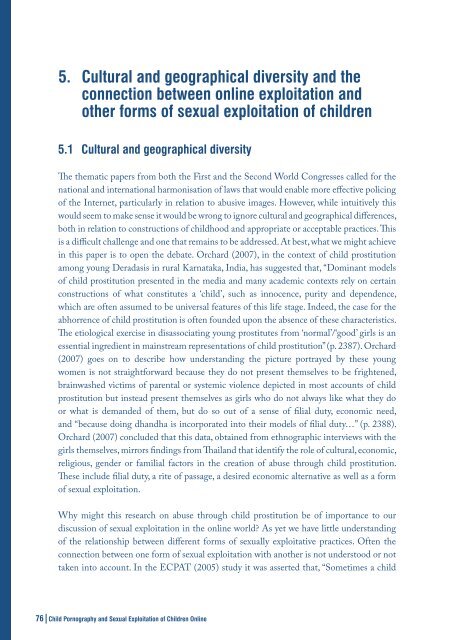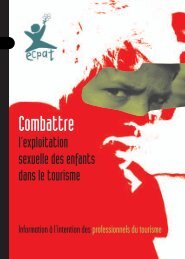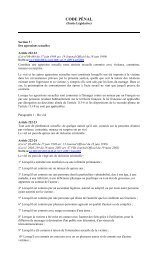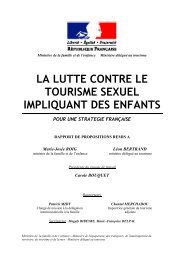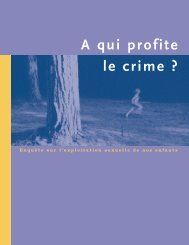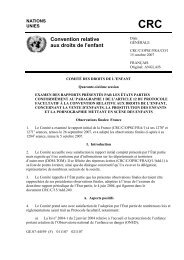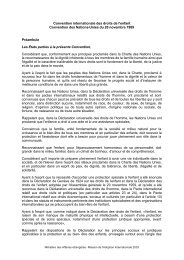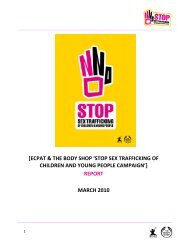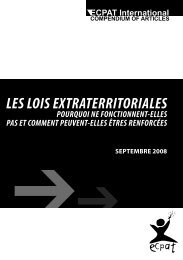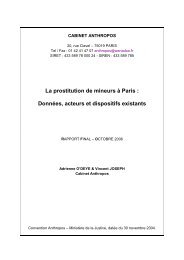child pornography and sexual exploitation of children online
child pornography and sexual exploitation of children online
child pornography and sexual exploitation of children online
You also want an ePaper? Increase the reach of your titles
YUMPU automatically turns print PDFs into web optimized ePapers that Google loves.
5. Cultural <strong>and</strong> geographical diversity <strong>and</strong> the<br />
connection between <strong>online</strong> <strong>exploitation</strong> <strong>and</strong><br />
other forms <strong>of</strong> <strong>sexual</strong> <strong>exploitation</strong> <strong>of</strong> <strong>child</strong>ren<br />
5.1 Cultural <strong>and</strong> geographical diversity<br />
The thematic papers from both the First <strong>and</strong> the Second World Congresses called for the<br />
national <strong>and</strong> international harmonisation <strong>of</strong> laws that would enable more effective policing<br />
<strong>of</strong> the Internet, particularly in relation to abusive images. However, while intuitively this<br />
would seem to make sense it would be wrong to ignore cultural <strong>and</strong> geographical differences,<br />
both in relation to constructions <strong>of</strong> <strong>child</strong>hood <strong>and</strong> appropriate or acceptable practices. This<br />
is a difficult challenge <strong>and</strong> one that remains to be addressed. At best, what we might achieve<br />
in this paper is to open the debate. Orchard (2007), in the context <strong>of</strong> <strong>child</strong> prostitution<br />
among young Deradasis in rural Karnataka, India, has suggested that, “Dominant models<br />
<strong>of</strong> <strong>child</strong> prostitution presented in the media <strong>and</strong> many academic contexts rely on certain<br />
constructions <strong>of</strong> what constitutes a ‘<strong>child</strong>’, such as innocence, purity <strong>and</strong> dependence,<br />
which are <strong>of</strong>ten assumed to be universal features <strong>of</strong> this life stage. Indeed, the case for the<br />
abhorrence <strong>of</strong> <strong>child</strong> prostitution is <strong>of</strong>ten founded upon the absence <strong>of</strong> these characteristics.<br />
The etiological exercise in disassociating young prostitutes from ‘normal’/‘good’ girls is an<br />
essential ingredient in mainstream representations <strong>of</strong> <strong>child</strong> prostitution” (p. 2387). Orchard<br />
(2007) goes on to describe how underst<strong>and</strong>ing the picture portrayed by these young<br />
women is not straightforward because they do not present themselves to be frightened,<br />
brainwashed victims <strong>of</strong> parental or systemic violence depicted in most accounts <strong>of</strong> <strong>child</strong><br />
prostitution but instead present themselves as girls who do not always like what they do<br />
or what is dem<strong>and</strong>ed <strong>of</strong> them, but do so out <strong>of</strong> a sense <strong>of</strong> filial duty, economic need,<br />
<strong>and</strong> “because doing dh<strong>and</strong>ha is incorporated into their models <strong>of</strong> filial duty…” (p. 2388).<br />
Orchard (2007) concluded that this data, obtained from ethnographic interviews with the<br />
girls themselves, mirrors findings from Thail<strong>and</strong> that identify the role <strong>of</strong> cultural, economic,<br />
religious, gender or familial factors in the creation <strong>of</strong> abuse through <strong>child</strong> prostitution.<br />
These include filial duty, a rite <strong>of</strong> passage, a desired economic alternative as well as a form<br />
<strong>of</strong> <strong>sexual</strong> <strong>exploitation</strong>.<br />
Why might this research on abuse through <strong>child</strong> prostitution be <strong>of</strong> importance to our<br />
discussion <strong>of</strong> <strong>sexual</strong> <strong>exploitation</strong> in the <strong>online</strong> world? As yet we have little underst<strong>and</strong>ing<br />
<strong>of</strong> the relationship between different forms <strong>of</strong> <strong>sexual</strong>ly exploitative practices. Often the<br />
connection between one form <strong>of</strong> <strong>sexual</strong> <strong>exploitation</strong> with another is not understood or not<br />
taken into account. In the ECPAT (2005) study it was asserted that, “Sometimes a <strong>child</strong><br />
76|Child Pornography <strong>and</strong> Sexual Exploitation <strong>of</strong> Children Online


